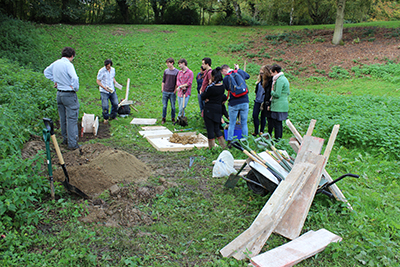The UK’s leading expert on rammed earth — Rowland Keable — ran a workshop for Kent School of Architecture students on Wednesday, 15 October 2014. Students built a sample rammed earth wall, using clay, aggregate and sand materials dug from the site, learning many lessons about the principles of the method and the practicalities of this recently re-discovered construction technology.
Rammed earth is a more-sustainable alternative to concrete and masonry, and has been used around the world for thousands of years. It employs the earth dug up from the building site itself to build the walls, which are formed by ramming the material into formwork (similar to that used for concrete structures). However, the environmental impact of rammed-earth is much lower than that of concrete because it does not use any cement, and therefore results in very significantly reduced carbon dioxide emissions.
Rowland Keable advised on the rammed earth walls at the Eden Project in Cornwall, the Education Building at the Centre for Alternative Technology in Wales, as well as, more locally, the rammed chalk walls at the Pines Calyx building in St Margaret’s Bay. He is acting as a consultant to Kent School of Architecture in connection with a feasibility study for the Crater Theatre — one of the University’s Beacon Projects celebrating the 50th anniversary of the University.
Prior to the workshop he gave a lecture on rammed earth to all stage 2 students in the school as part of the Architecture + Landscape module.
Student Ben Warner said ‘the notion of building a structure on site out of the very material it will sit upon sunk in as a very logical building method for the future – but more importantly, for the present. I hadn’t previously realised how very feasible rammed earth is. The workshop surely impacted my future design process. I suppose from now on I’ll be asking myself “Would rammed earth work here?” at the start of all future project’.
Rammed Earth Consulting
Keith Bothwell

